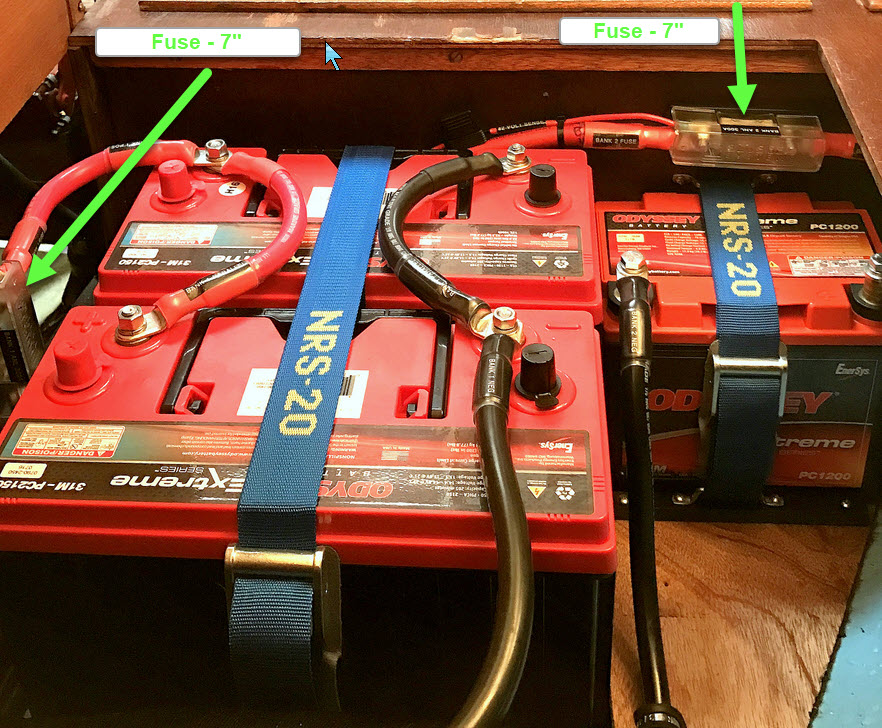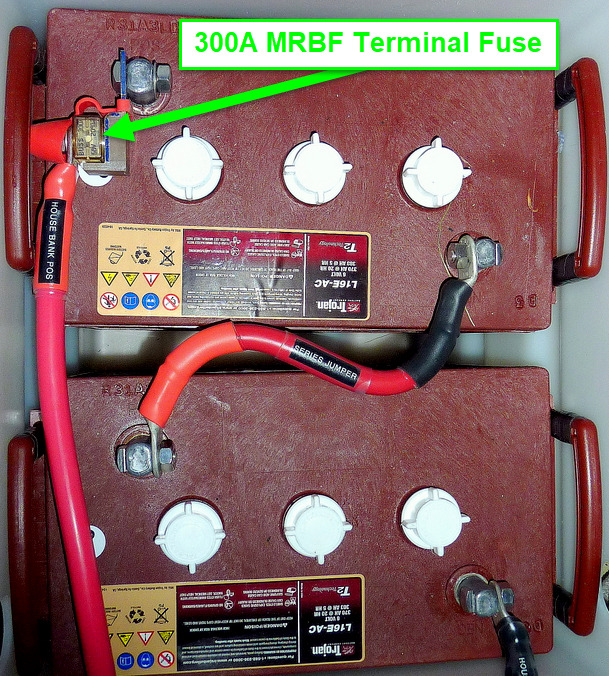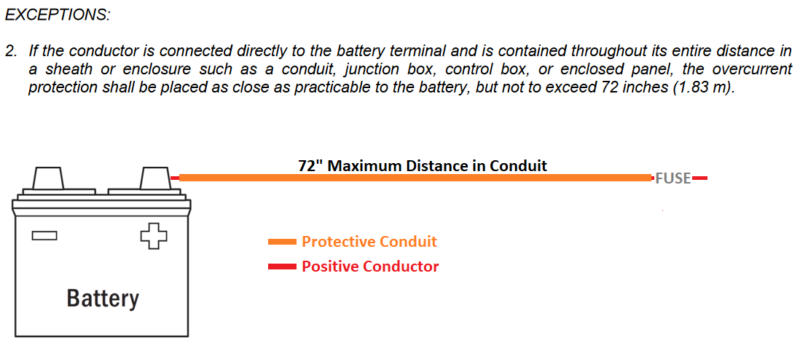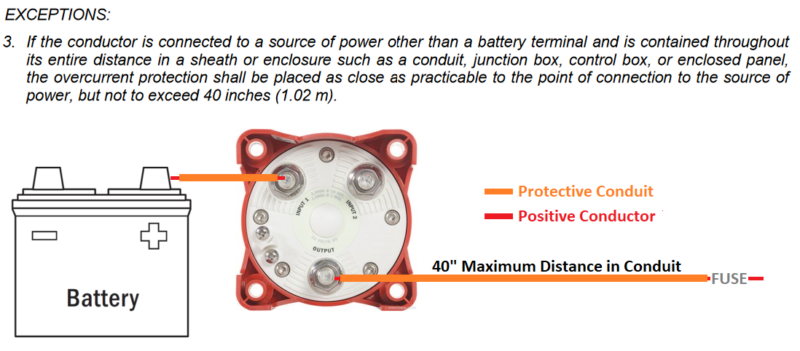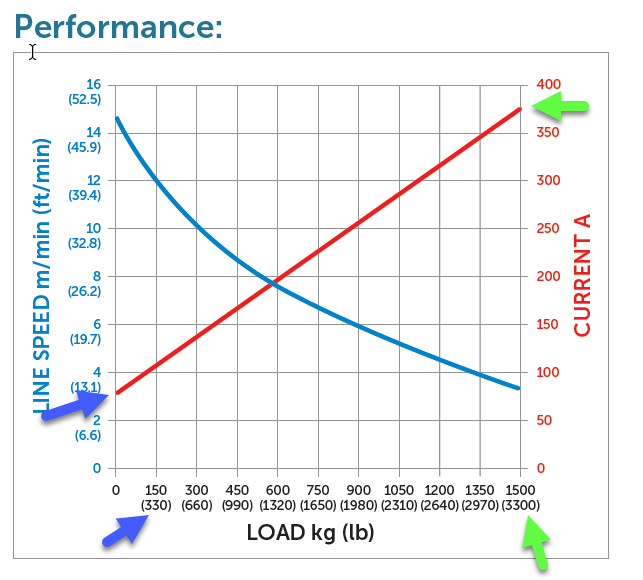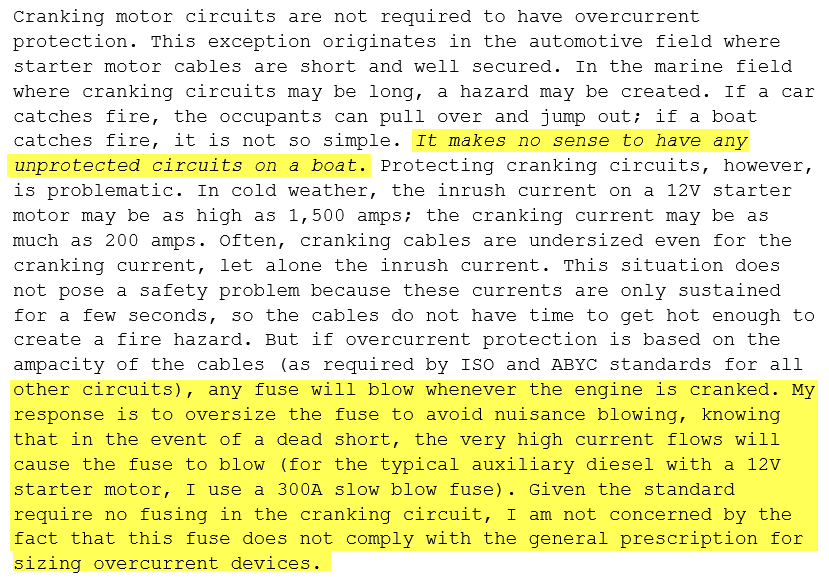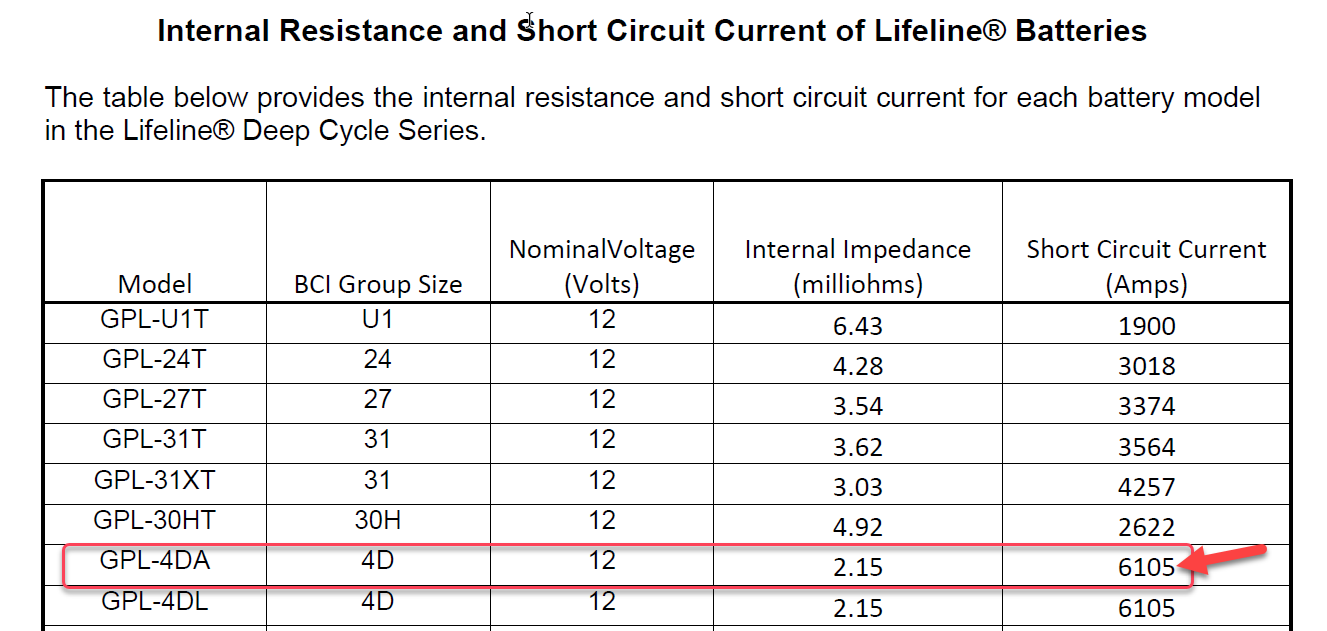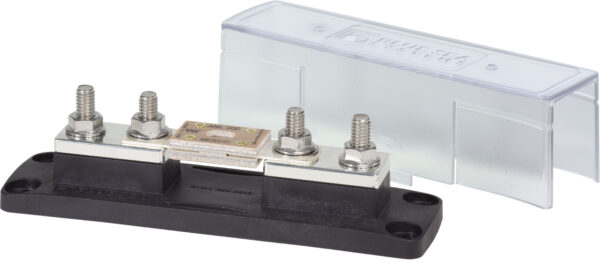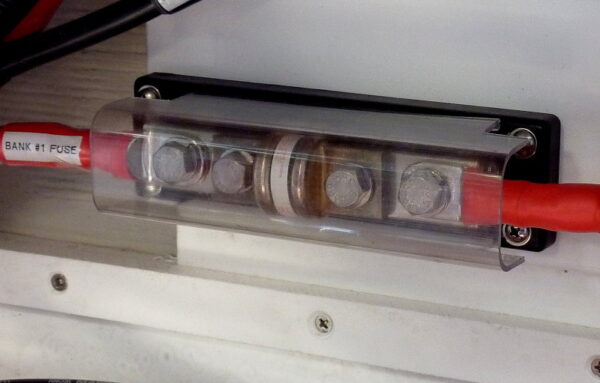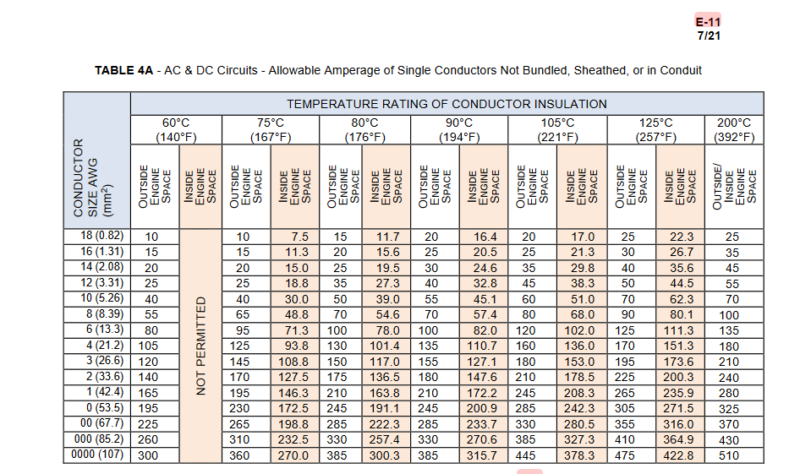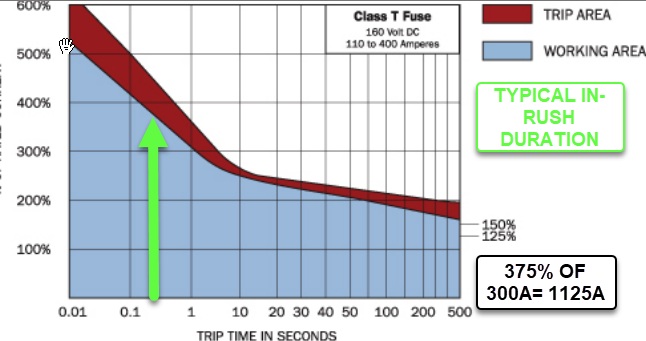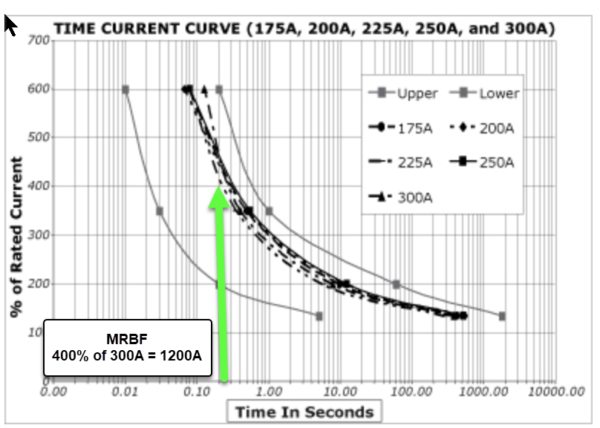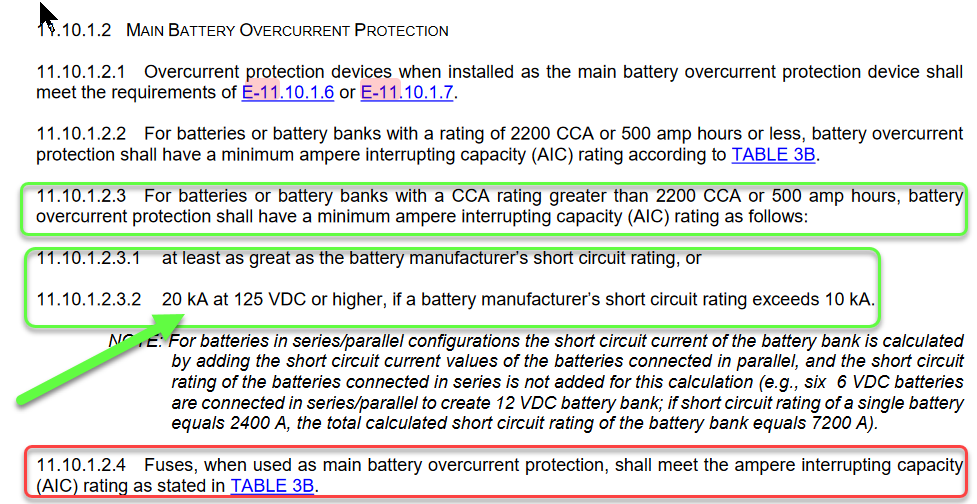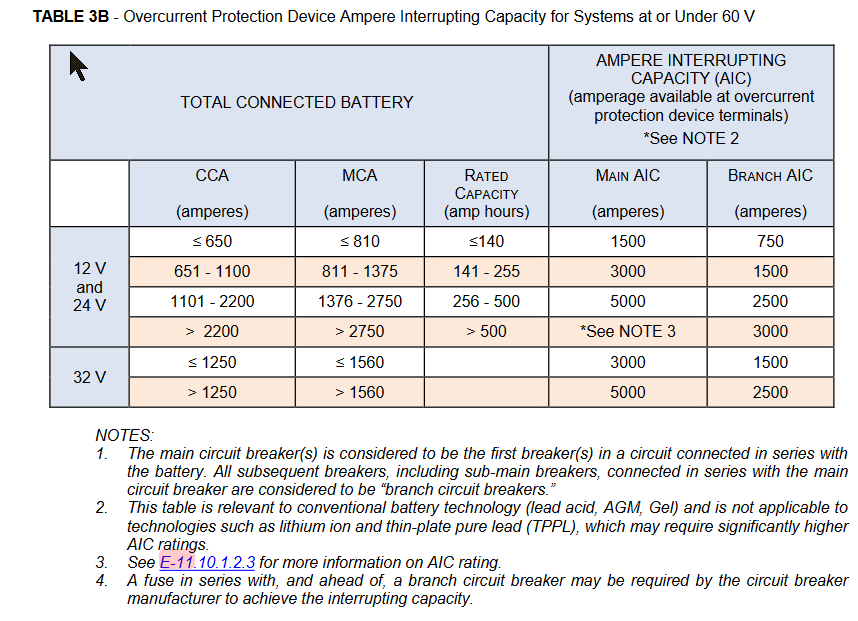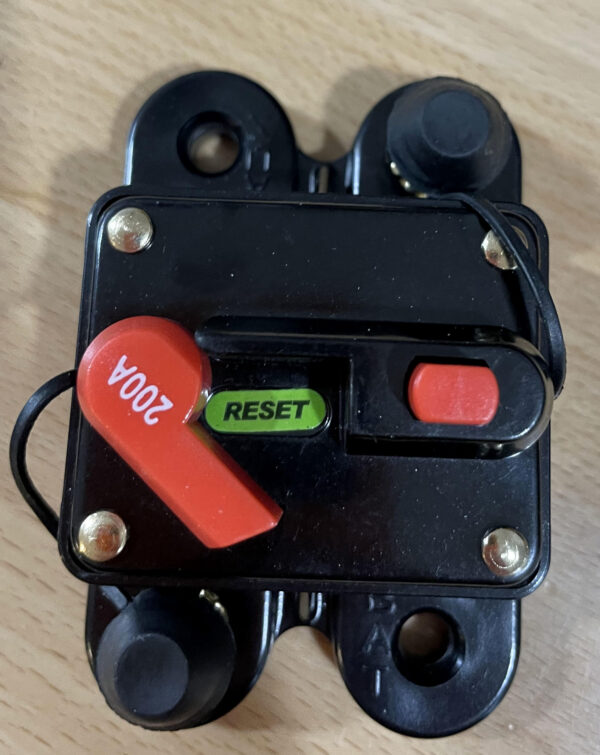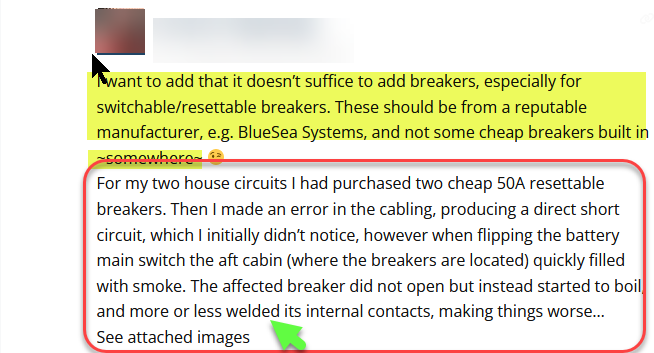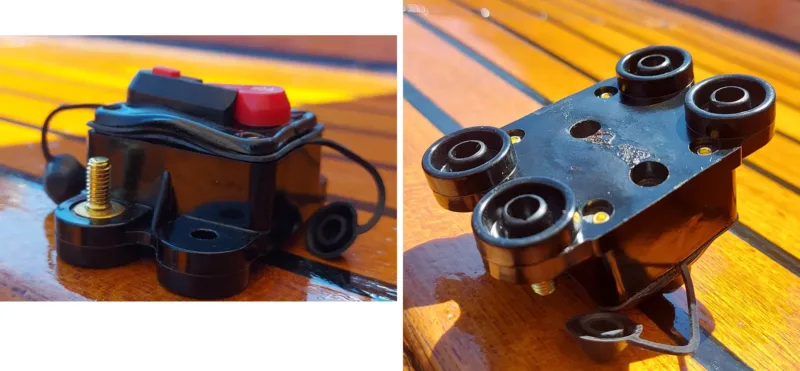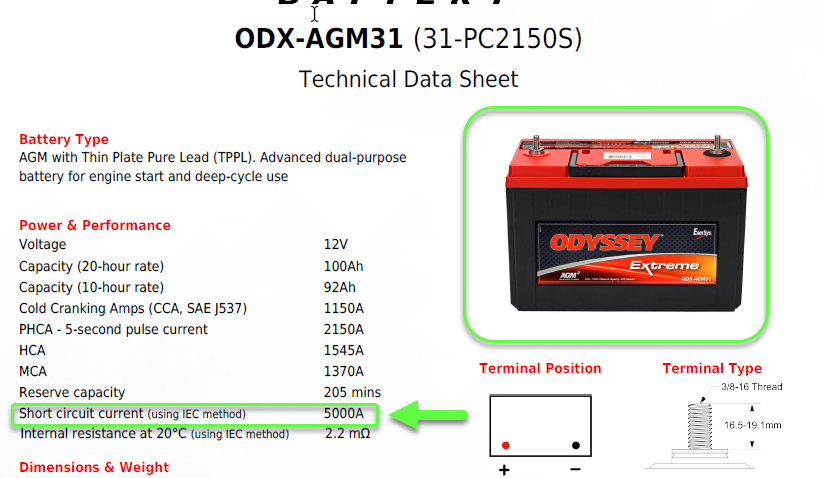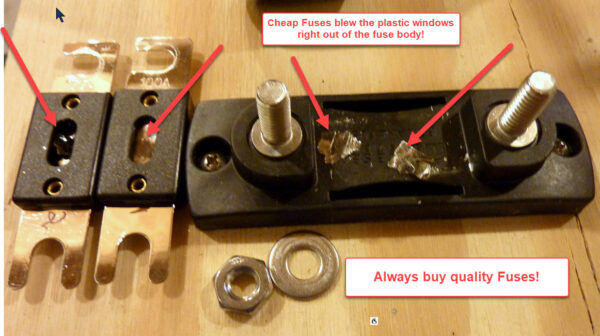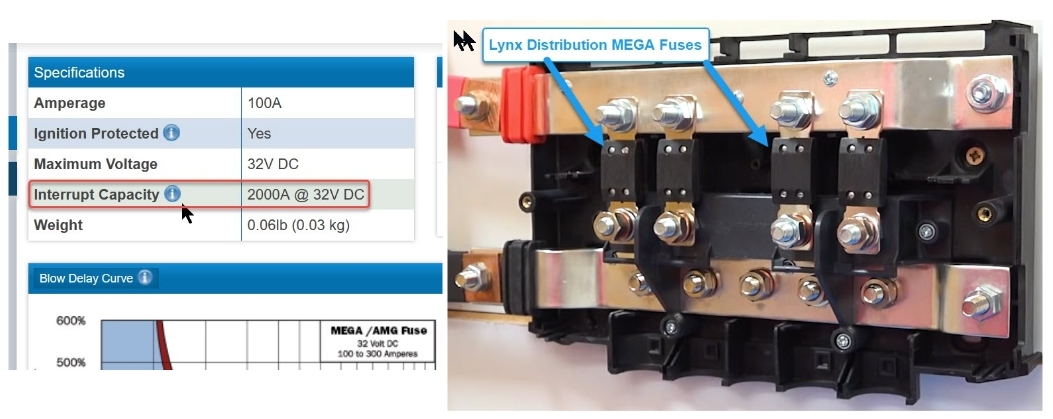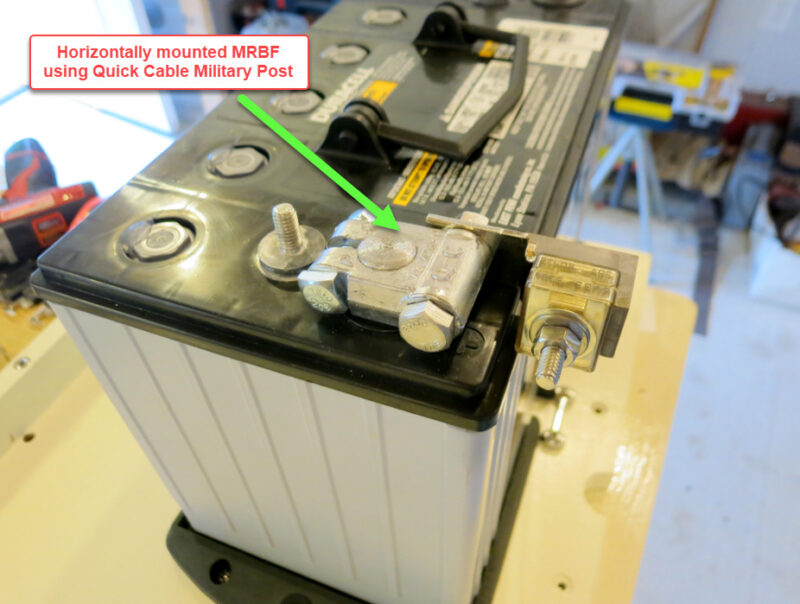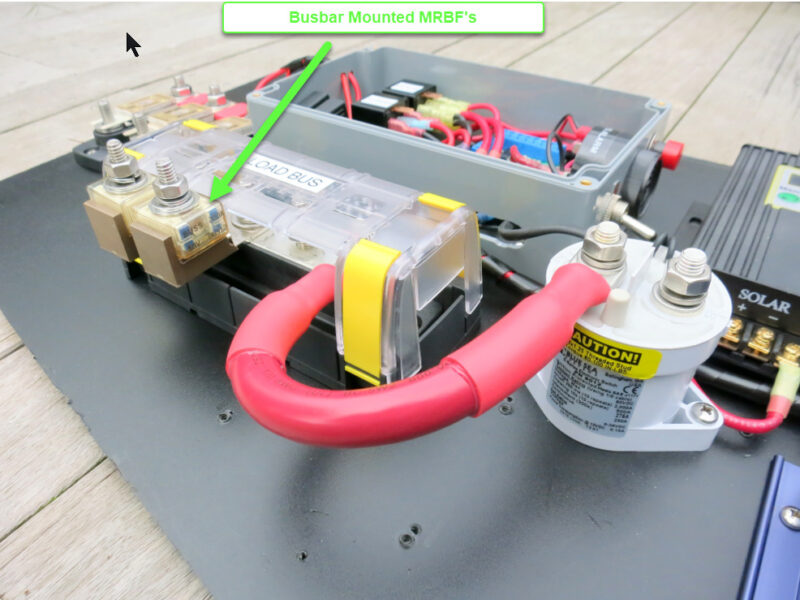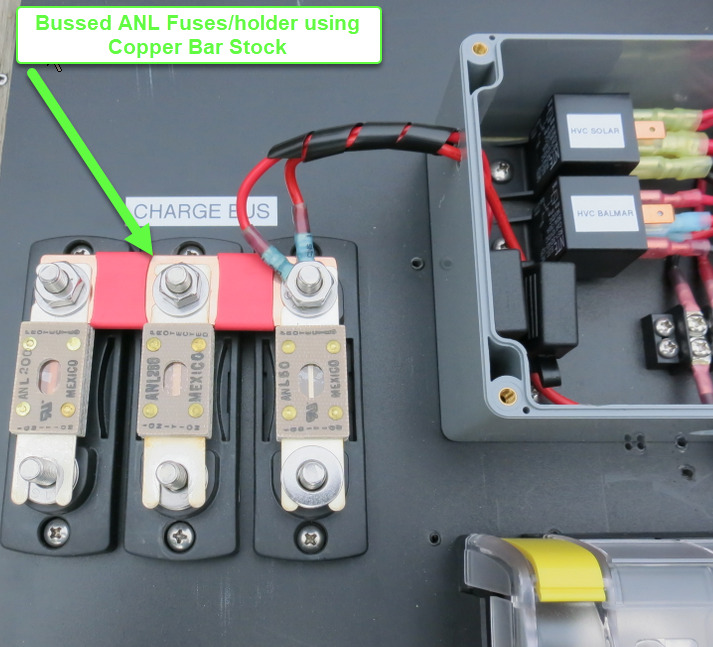Battery Banks & Over-Current Protection
A 300A (MRBF)Battery Terminal Mounted Fuse by Blue Sea Systems
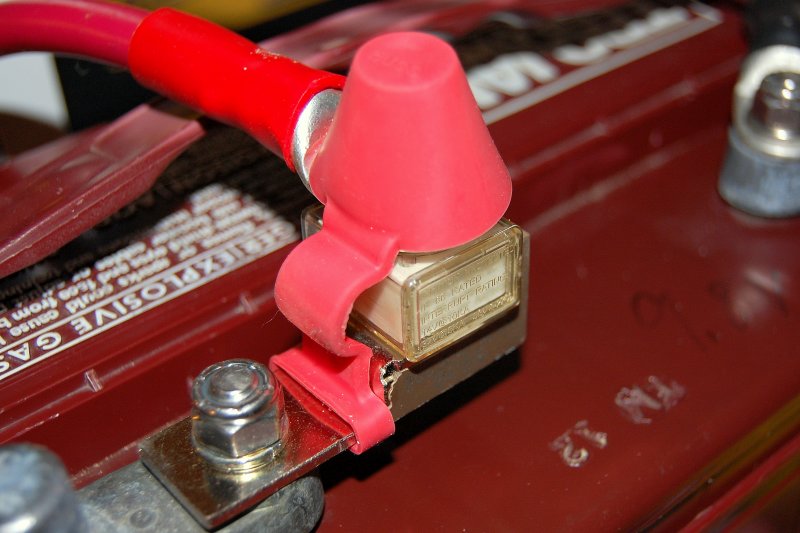
In this article we will discuss fuse selection, fuse types, wire ampacity, Amperage Interrupt Capacity (AIC) and even potentially unsafe ABYC “exceptions to the rules”. In short, this article deals with why fusing your battery banks is a critical safety measure.
IMPORTANT: Every DC positive conductor on the boat requires OCP!
MHT Recommended Fuses & Holders
The Fuses/holders below are the only ones we recommend for battery bank protection on a boat. We have simplified searching all over Amazon for you and provided a direct link. To Satisfy the FTC:Affiliate Disclaimer Link
BUY MHT RECOMMENDED FUSES & HOLDERS
Bank Fusing Steps
1 – Know the amperage of the load you need to fuse
2 – Know the Ampacity of the wire you are trying to protect
3 – Determine the AIC of the bank you are trying to protect
ABYC = Bare Minimum not Maximum
In regards to over-current protection of battery banks, owners should consider that the ABYC standards are a bare minimum requirement. In many cases, especially battery bank protection, certain aspects of ABYC E-11’s battery bank over-current protection should be considered as inadequate, potentially unsafe and below where a boat-owner should set their sights, if they want true safety. What the excerpt below is Saying is that any + conductor connected to a battery bank requires over current protection within 7 inches of the batteries positive terminal. This includes house banks, windlass banks, thruster & winch banks.
The House Bank Requires OCP!
Yes, I am an ABYC member, ABYC certified electrician and also part of the electrical sub-committee that helps develop these standards. Sometimes rational arguments made by the likes of Nigel Calder, myself and numerous others are over-shadowed in favor of taking a shortcut or to save boat-builders money. In many cases you can and should aim to exceed the ABYC standards. Specifically with regard battery bank fusing or sheathed/loomed or conduit protected wire.
Definitions Used:
Ampere Interrupting Capacity (AIC) – the maximum short-circuit current that an over-current protection device can safely interrupt under standard test conditions.
Source of Power – In regards to battery bank over-current protection the battery bank is the “source of power” that we are protecting the wires from.
Conduit – an enclosure that is part of a closed wiring system for insulated conductors and/or cables in electrical installations, allowing them to be drawn in and/or replaced. Conduit or sleeving also serves to protect from chafing and shorting.
Equipment Enclosure – the outside shell of equipment that provides personnel protection from electrical hazards, burns, rotating machinery, and sharp edges, and provides protection to the device from mechanical damage or weather.
Ignition Protection – the design and construction of a device such that under typical design operating condition, will not ignite a flammable hydrocarbon mixture surrounding the device when an ignition source causes an internal explosion, or it is incapable of releasing sufficient electrical or thermal energy to ignite a hydrocarbon mixture, or the source of ignition is hermetically sealed.
Loom – a flexible covering designed to protect conductors.
Main Over-current Protection Device – an over current protection device with no other over current protection between it and the source of power.
Pigtails – provided conductors integral to an electrical component or appliance for the purpose of connection to external circuits. eg; LED navigation lighting.
Self-limiting Device – a device whose maximum output is restricted to a specified value by its magnetic or electrical characteristics.
Sheath – a material used as a continuous protective covering, such as overlapping electrical tape, woven sleeving, molded rubber, molded plastic, loom, or flexible tubing, around one or more insulated conductors.
The bank fuse is there to protect the wire!
The ABYC Standards on Battery Bank Fusing:
Fuse Location:
The ABYC requirement is for a battery bank fuse is to be within 7 wire inches of the battery bank. The European ISO/RCD (which is law) requires the fuse be within 200mm. 200mm equates to about 7.9”. In this regard, the European ISO/RCD is essentially the same as the ABYC’s 7” requirement. The difference here is the ABYC standards are still voluntary. I only point this out because we hear time and again that the ABYC is not a law, and it is not, but the ISO/RCD (recreational Craft Directive) is a law.
These fuses, one for each bank, are in compliance with ABYC E-11. The one on the cranking battery exceeds and goes above and beyond the ABYC standards.
In the real world of boats and battery compartments meeting the 7” rule is not always as easy as it sounds. If you can’t get within 7″ then the next best thing is to be as close as possible but the wire should always be in a protective conduit or flexible loom, once the jumper to the fuse exceeds 7″.
If you’re having trouble meeting the 7″ rule, the Blue Sea battery terminal fuses shown in this photo are an excellent option for up to 300A. If trying to fuse a bank that may ever need to be used to start a bigger engine, you may need a Class T or ANL fuse and the correct fuse holder..
These fuses are excellent but they do add nearly 2″, in height, to a battery post, if vertically mounted so measure your battery compartment height carefully.
Exceptions to the 7” Rule:
While the standards do have an allowable exception for over current protection regarding cranking conductors. Nowhere in the ABYC standards does it suggests not fusing cranking conductors. In other words, the ABYC is not saying “don’t fuse a creaking conductor” they’re simply allowing you an exception to the rule if your engine is too big to be fused.
It is quite often repeated as fact on the Internet, by folks who don’t understand what they’re talking about, that the ABYC says “don’t fuse engine cranking conductors”. The standards say no such thing.
Other Exceptions to the 7” Rule:
Under ABYC E-11 the fuse does not always need to be within 7”. Depending upon the location & where the wire connects to, meaning the battery or other source of power, such as a battery switch, and when “contained throughout its entire distances in a sheath, or enclosure such as a conduit, junction box, control box, or enclosed panel” the fuse can be either at a maximum distance of 40” or 72”.
72” Exception to the 7” Rule:
40” Exception to the 7” Rule:
“Exceptions” to Bank Fusing – Do They Always Make Sense?
Remember above where we mentioned that the ABYC standards are a bare minimum and you can often do better? Well, exception #1 “cranking conductors is one area where the ABYC is simply leaving far too much room for dangerous installations.
In today’s day and age you can, and ideally should, strive to achieve better than the extremely low bar set by ABYC E-11 on bank fusing. Compass Marine inc. has been fusing cranking conductors since the mid 90’s and these circuits have likely undergone hundreds of thousands of engine-starts. I can count on two fingers the number of nuisance trips we’ve had.
#1 An engine that hydro-locked due to a scoop strainer installed with the scoop facing forward. (darn good thing the fuse tripped)
#2 A boat that tangled in lobster gear and the reversing gear was stuck in gear. The owner tried to start it anyway. (Again, it’s a darn good thing the fuse tripped.)
Sure, using the “cranking conductor” exception is an easy mark for a boat builder, as it saves them money, but many of us who do this for a living find this exception to be patently unsafe without also mandating the cranking conductors be located in a protective conduit/sleeve. Nigel Calder is one such individual who also believes this exception is not one to use (see excerpts below).
The argument a few of the members of the ABYC committees make is that starting motors draw too much current and are difficult to fuse. Ok, if this is the argument, why don’t we take a look at devices such as DC powered bow thrusters. A bow thruster is not a cranking conductor so by the ABYC standards that connection to the thruster bank must be fused.
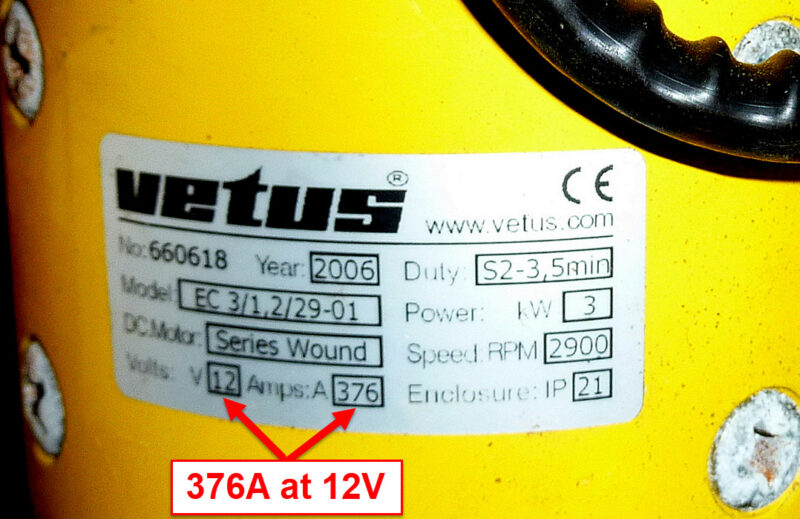
This series wound thruster motor is exactly like a typical marine engine starter motor. The only difference is that it actually draws a lot more current, and for a lot longer, than you’ll find on the vast majority of marine engines.
The difference between a starter motor and a thruster are however huge. A typical engine starting duration ranges from about * 0.75 seconds to 1.5 seconds on average(*data Midtronics EXP 1000HD) . Bow thruster motors are rated for as much as 3-5 minutes and many owners use them for 30 seconds or more at a blast. The bottom line is this; a bow thruster is treating a fuse in a much more abusive manner than a starter motor ever will! The ABYC requires the bank feeding this bow thruster to be fused but not starter motors? This is about as nonsensical and hypocritical as your everyday politician( either side of the aisle, your pick)!
This particular bow thruster draws well over 1000A for in-rush, and physically maxes out our Fluke 376 which can measure to 1000A DC for in-rush. Under actual thrusting loads it typically pulls 330-365A, for as long as 30 seconds or more at a time. On land, with no load/water to move, it draws about 285A +/- which is pretty much spot-on for the motors 376A rating. Also keep in mind this is not the biggest 12V thruster we deal with.
“But, the motor says 3kW what about Ohm’s law?”
3 kW = 3000W If we take a typical no-load rating of the motor this is; 3000W/11.5V = 261A
11.5V is a perfectly acceptable voltage sag on a bow thruster bank under that type of load. However, as I mentioned, this is a “no-load” rating meaning no gears to turn, propeller to spin or water to move. This is how and why a 3kW motor can typically draw much more current than the face value 3kW rating.
“But, the rating plate says 376A, why does it disagree with the 3 kW rating?”
Yes, the rating plate may say 3kW and 376A but the motor wattage rating is a no-load rating. Put a load on any DC motor and it will draw more power than the no-load wattage rating indicates. See chart below.
One more example:
This is the current spec from an Anderson Electric Winch we installed. The ABYC requires these winch batteries to be fused. Notice how high the in-rush is (green square)?
 And here is a chart showing the winch current draw based on winch load. As stated, apply a load to an electric motor and it will draw more than its face value rating.
And here is a chart showing the winch current draw based on winch load. As stated, apply a load to an electric motor and it will draw more than its face value rating.
The point in all this discussion on bow thrusters and electric winches is to examine why mandating over-current protection for DC bow thrusters/winches and then making “exceptions” for engine starting motors is actually pretty silly..
What would make a cranking conductor fuse exception ok?
A fuse exception would be OK if the ABYC actually mandated un-fused cranking conductors to be protected in a protective sheath, conduit, sleeve etc. like the 40” and 72” rules do, but the standards do not call for this. Unsleeved/unprotected wire is perfectly fine for a cranking conductor under ABYC E-11. Crazy? You Bet bet is!
What AWG do manufacturers suggest for cranking conductors?
Here are some minimum manufacturer suggestions for battery/starter cable from Westerbeke and Universal.
Universal / Westerbeke minimum wire size requirements (wire length round-trip)
2 AWG = 8′
1 AWG= 10′
1/0 AWG = 14′
2/0 AWG = 18′
3/0 AWG = 22′
4/0 AWG = 28′
Nigel Calder addresses the fusing of cranking conductors in his books;
Begin Quote – Nigel Calder:
End Quote:
and
Quote Nigel Calder:
End Quote:
A real-world example of why this exception can be dangerous.
Exceptions to the Rule vs. Common Sense
In August of 2010 a local yacht clubs junior sailing program had a chase boat returning to the dock with a few 8-10-year-old junior sailors, and their coach. They were aboard a well maintained 15’ Boston Whaler. As they tied up to the dock, the battery cables under the helm seat started to smoke. Within seconds the entire boat was engulfed in flames. The boat was a total loss. The kids barely made it off the boat before the fire fully engulfed the vessel.
Points to Consider:
- The ABYC standards do not even require a battery switch let alone a main bank fuse for this boat!
- This tiny Honda outboard is very, very easy to fuse with an MRBF battery terminal mounted fuse!
- This boat fire was driven by a single group 27 battery, into shorted 6 GA wire!
What if this happened when the kids & coach were out on the bay, not as they approached the dock? Safe? Hell no!
If a single G-27 battery can do this to the Honda outboards factory supplied wire, & this boat, what do you suppose two 8D cranking batteries will do to your wire & boat if the wire shorts?
A small MRBF fuse holder & fuse, that costs $30.00, would have 100% prevented this fire.
The bank below is capable of 18,000A of short circuit current!
The installer put the wires in protective loom and went above and beyond what the ABYC requires. Smart guy!
Fuses Work!
Below is an example where the owner’s boat was protected by a fuse. This owner had a 1/2/B switch and decided it would be a good idea to fuse both banks. A year after doing this DIY upgrade he had a plastic wire-tie fail and the large gauge battery cable came in contact with the engine.
The 300A fuse, that was protecting this wire, saved this owners boat from burning to the waterline.
Foolish to not protect all batteries with over-current protection or a protective conduit? You bet it is!
Bare Minimum Fuse Sizes
Let’s cut-to-the-chase on this. Below are the minimum bank fusing we prefer to see for any bank that could ever be called upon to start a motor. If your vessel has a 1/2/B switch both banks need to be capable of starting the engine.
Bare minimum fuse size for small diesel engines 8HP to 25HP = 250A
Bare minimum fuse size for medium diesel engines 25HP to 60HP = 300A
Above 60HP 75% of measured *inrush current as minimum fuse size.
*You will need a clamp meter such as a Fluke 376, or equivalent, to measure the inrush.
If you follow the above guidelines, you will not suffer “nuisance trips” if fusing your starting bank.
If your engine is too large for a fuse put the entire length of the cranking conductor in a protective conduit or protective loom! Unprotected battery cables are a fire waiting to happen!
Selecting the Proper Type of Fuse:
Battery banks larger than 255Ah should be protected with fuses not breakers. The following types of fuses are suitable for main bank protection:
ANL
CLASS T (preferred for Li-ion& large AGM Banks)
MRBF
These fuses are available from Blue Sea Systems and other reputable sellers. They should however be “Ignition Protected” fuses if installed on a gasoline boat and Blue Sea Systems is the only one I know of offering ANL fuses with ignition or spark protection for ANL’s. Class T fuses are not technically IP rated however they are fully encased in a metal body. Class T fuses have simply not been tested for IP rather than do not meet IP. In speaking with Blue Sea systems I was told they have no documented cases of an IP breach on any Class T fuses.
Remember, the main battery over current protection (OCP) or over current protection device (OCPD) is sized to protect the wire. The main bank fuse is not there to protect the down-stream equipment. Those fuses would be located after the main bank protection fuse. This is often misunderstood.
You can always go smaller with OCP than the wires ampacity rating, but ideally should not exceed the ampacity rating unless you are fusing the battery bank and the bank could potentially be called upon to crank a motor. The main bank fuses are there to prevent the wire from overheating, melting and starting a fire in a dead short situation. Generally speaking a fuse is sized to not exceed the maximum ampacity of the wire. In certain instances the ABYC allows for up to 150% of the chart below.
ABYC E-11 Wire Ampacity Chart
The chart below is for single conductors not bundled, sheathed or in a conduit. For bundled charts refer to ABYC E-11. If you are using a quality UL 1426 Marine wire it will be the 105C column.
What if my engine draws more than the wiring is rated for?
Nigel Calder clearly addressed this above and this is actually not uncommon at all. Many builders undersized starting wire for many years, and got away with it, due to the short-duration starting circuits are physically current-loaded for. Today, most builders have come up closer to where they should be for wire ampacity.
A good example of this is the original Universal M-25 as shipped on Catalina Yachts in the 80’s and most of the 90’s. Catalina used to ship the Universal M-25’s with 4GA battery wire. In the late 90’s they began shipping the same engine, a Universal M-25XPB, with 2/0 gauge wire. Going from 4 AWG to 2/0 AWG is a huge improvement. If you have small gauge wire, an upgrade to larger wire can be a very good investment. Your engine will also start quicker and the starter will see a lot less voltage-drop. Larger wire means you’ll be able to develop more cranking current for faster starts. Nearly every sailboat I went aboard during the last boat show, including a tailerable 28 footer, was using 1/0 or larger wire with 1/0 and 2/0 being the most popular in boats over 30′.
Won’t the starters in-rush current blow my fuse?
First, let’s identify what in-rush current really is? In-rush current is the very brief spike in current that the starter undergoes to get the motor to begin turning over from a stopped state. The in-rush duration is usually about 100ms to 300ms long, and is not long enough to blow a properly sized fuse. ANL, MRBF or Class T fuses are not sized for the inrush, they are sized so they don’t nuisance trip when cranking an engine.
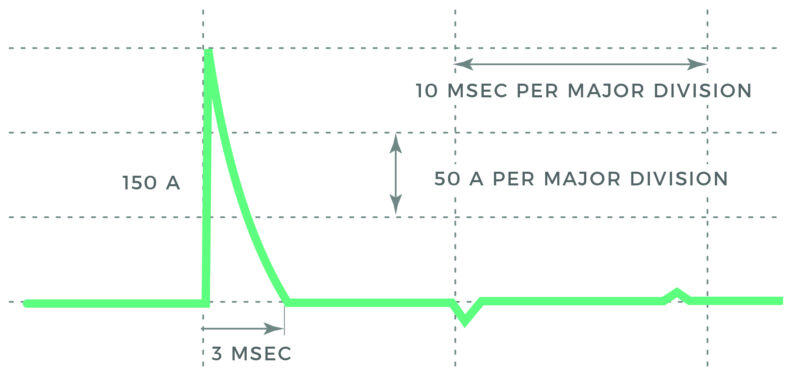 Compare the in-rush duration to a fuse rated for main bank protection and it becomes clear as to hoe this is so.
Compare the in-rush duration to a fuse rated for main bank protection and it becomes clear as to hoe this is so.
ANL FUSE- TRIP DELAY CURVE
CLASS-T FUSE -TRIP DELAY CURVE
MRBF TRIP-DELAY CURVE
Contrary to popular misconception fuses don’t always trip at their face value rating. You also need a long enough duration at high current. As can be seen above, each fuse has a trip-delay curve. These curves are from Blue Sea Systems.
If you look closely, a 300A Blue Sea Systems ANL fuse can support 600% of its rating, or nearly 1800A, for approximately 0.5 Seconds. The inrush duration is not this long.
If we look at the trip-delay curves above it becomes quite clear that ANL, Class-T or MRBF do not trip at face value unless the duration of high-current is long enough.
For example, a 300A Blue Sea Systems ANL fuse can handle 300% of its rating for an entire second or 900A. Peak cranking currents just don’t last this long. If we look to the far right of the trip-delay graph you can see that it would take nearly 500 seconds or 8.3 minutes at 150% of the ANL fuses rating to actually trip. For a 300A fuse this is 450A for as long eight minutes or so. This is the reason why fusing cranking circuits is not the problematic concern some make it out to be. You just need to size the fuse correctly.
300 AMP ANL Seconds vs. Trip-Amperage
.7 Seconds =1800A
1 Second = 900A
5 Seconds = 500A
500 Seconds =450A
AIC & Why It’s Critically Important!
AIC stand for Amperage Interrupt Capacity. The AIC is sometimes called “interrupt capacity”too. AIC is the short circuit amperage capacity the fuse or breaker can “interrupt safely” without welding shut, blowing up and losing “ignition protection” or jumping the gap and failing to provide protection..
The ABYC Standard
The green arrow is pointing to a specification that can only be met by a Class T fuse!
Table 3B below.
Not All Fuses/breakers are Created equal!
Not all fuses/breakers are created equal. Always Stick with fuses by Blue Sea Systems, Cooper Bussmann or Littlelfuse.
When ordering from less than reputable sellers make sure the products can meet the following;
Avoid purchasing direct from China fuses/breakers off of Amazon! The customer below learned a very hard lesson. The pictured no-name breaker came from Amazon and the customer certainly got scammed! The 200A breaker was consistently tripping every time his alternator output got to 85A! Amazon refused to publish his review on the product! The alternator load dumps caused his alternator to fail and also took out his brand new B&G plotter! Cutting corners on fuses/breakers can cost you big time.
And here’s a guy who’s budget breaker welded itself shut! This is why AIC Matters!
*Images below courtesy Attainable Adventure Cruising
The welded & melted breaker
Below is another example of why AIC maters. The fuse below was attached directly to the battery + terminal and when it tripped it failed in a manner that it kept allowing current to pass. The owner noticed a fumy smell and it was his bilge pump starting to melt.!
The meter is still showing continuity even though the fuse clearly tried to blow! The AIC rating of the fuse maters!
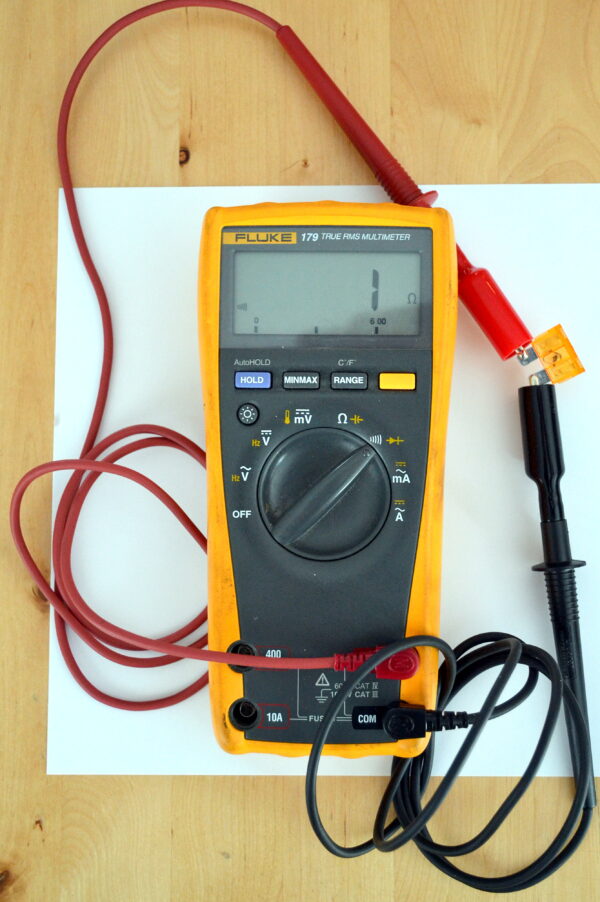
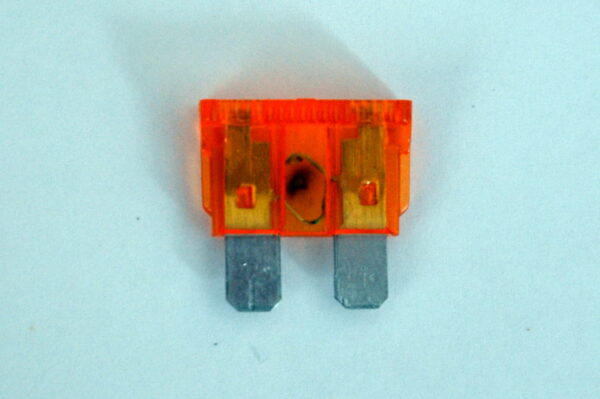
The above ATC Fuse only had an AIC of 1000A yet was directly connected to a bank of AGM batteries that could deliver 20,000A of short-circuit current
ATC Fuse AIC
What Fuses have an AIC that is suitable for a cruising boat bank?
Class T, ANL and MRBF fuses all have an AIC that can be suitable for house banks. If you have a large bank of AGM or Lithium batteries then a Class T fuse is the best fuse to meet the AIC requirements. For LiFePO4you really want to use class T. ABYC E-13 specifically calls this out.. The AIC rating of Class T fuses is 20,000 amps at 125V. It is significantly higher at 12V but Blue Sea Systems has not run the AIC tests at 12V. A 20,000A rating at 125V is a very, very impressive AIC rating. The Class-T fuse is the most robust fuse we use in the marine environment because it is fully metal encased.
ANL fuses have AIC of 6000A at 32V and MRBF fuses are 10,000A at 14V.
What about Breakers & AIC?
The concern with AIC & breakers is that breakers can literally weld shut before tripping, if the bank has enough short-circuit current behind it. For smallish house battery banks, you ideally want an AIC rated fuse or breaker of 5000A AIC or greater. Even Blue Seas Best class of breaker, the 187 series is only rated at 5000A AIC.
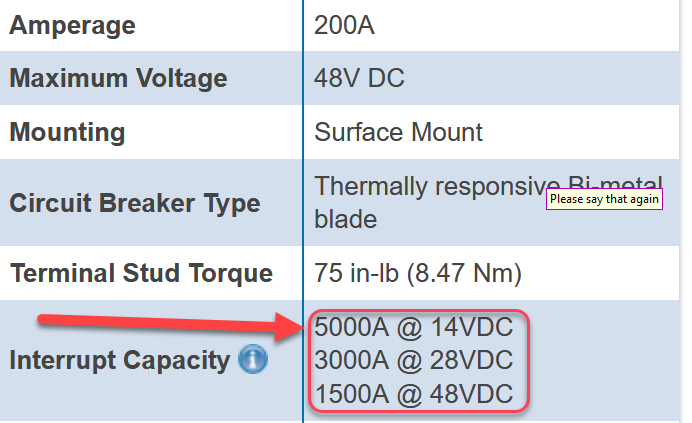
Just one group31 Odyssey TPPL AGM is capable of 5000A of short circuit current! Please understand that AIC is not just for large AGM banks or LiFePO4 batteries. A single 100Ah Group 31 Odyssey AGM battery can deliver 5000A of short circuit current into a dead short. A 200Ah bank of Group 31 Odyssey AGM batteries is 10,000A into a dead short. This is why the AIC rating of the over-current device is critically important.
The actual ABYC requirement for batteries is that any bank over 255Ah needs 5000A AIC rated protection or greater.
Cheap Fuses have no place on your boat
For the ABYC Li-Ion Battery sub-committee I spent A full day blowing all types of fuses and one thing that was seen very early on is that all fuses are not at all created equally. When a fuse trips it needs to trip in a safe manner. Knock of fuses, often found on the internet for car stereos, etc. are not built to the same standards as fuses from the likes of Blue Sea Systems, Littelfuse or Cooper Bussman. With a quick phone call any of these three companies you can quickly get all the testing data for any products they sell. Go ahead and try that with off-brandfuses/breakers you find on Amazon I know what the answer will be, we tried to do it for one of our customers who had a Scamazon breaker blow up one of his alternators. It tripped at just 110 A and was rated 250A! Sorry, no, this is not covered under warranty!
Blue Sea Systems ANL fuses have an IP rating “ignition protection” which is important on boats as the fuse must fail/trip safely so as not to ignite any on-board fumes. In the image below we have a bunch of cheap Amazon ANL fuses. A Blue Sea Systems ANL is built with G10 fiberglass sheet, features four rivets holding it together and uses a very durable Mica window. The cheap ANL fuses are a plastic body, two rivets and they use thin plastic windows that are prone to blow out when the fuse trips. We tripped 22 of these cheap fuses and the windows failed unsafely 20 out of 22 times. You can see the blown-out window in this image. When in doubt stick with fuses and fuse holders from Blue Sea Systems, Littelfuse or Cooper Bussman.
The photo below is a prime example of what can happen to a cheap ANL fuse. These claimed to be “ignition protected” (IP) and AIC rated fuses. After multiple emails to the vendor, they failed to provide any documentation to back any of these claims up? When buying fuses on Amazon it is certainly buyer beware! A few weeks later I noticed the specifications had magically changed and they no longer claimed IP or an AIC rating. Sadly, the only data I was able to find on the fuses was “Made in China“.
The fuses below were connected directly to a LiFePO4 lithium battery bank and then the circuit was shorted. The fuse trip was so violent, it literally blew the windows out of the fuses. This is an UNSAFE failure mode for a fuse. It failed for both AIC and ignition protection safety.
What About Victron Lynx Distribution Buses?
Victron has a beautiful line of distribution busses called the Lynx series. The Problem with these busses is they employ MEGA fuses that only have a AIC of 2000A. The solution is quite simple. You simply feed the distribution bus with a fuse that has the correct AIC Rating for the battery bank.Once the mega fuses are behind the main distribution fuse, a fuse that has the correct AIC rating, the MEGA fuses are now fine.
The Solution:
Pro Tips:
If you lack battery compartment height, and your batteries have lead posts, a military post can get you horizontal with an MRBF.
MRBF fuses work really well mounted to busbars
ANL or class T fuses/holders can be bussed together using copper bar stock from McMaster-Carr
Fuse Safely!!
Emergency!
We do not want to put this website behind a pay-wall!
Unfortunately, that is where we’re headed if our readers don’t help us with donations…
Please make a donation, that’s all we ask. Your donations are all we have to fund this web site. Please help to keep MarineHowTo.com a
FREE source of information!


